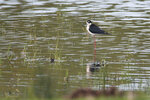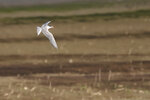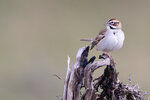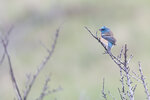



This column is mainly about local Thurston birds, but sometimes people journey around Washington and wonder whether the birds they see will be the same as back home. Some will be – robins and red-winged blackbirds are everywhere – but most will be different and that’s part of the fun of visiting new areas of our state.
One of the most remarkable areas of our state is the vast brushy desert of Central Washington, generally called the Potholes region. It is easily reached via I-90 and Moses Lake. Both the city and its namesake lake are its center. This is the area of the Columbia Basin Project (CBP), that huge irrigation project initiated in the 1930s.
Geologically, this area was glaciated – that is, covered in ice – and then swept by major floods. The result is a series of low areas, called potholes, and vast eroded canyons, called coulees. The keystone of the CBP is Grand Coulee Dam. The electricity it generates pumps water from the Columbia River up onto the Columbia Plateau, forming a large lake (Banks Lake). From there water is distributed to the south through a network of canals, lakes, smaller reservoirs, and ultimately through irrigation systems.
The natural rainfall in this region is only 5-10” per year, but thanks to the CBP, some 600,000 acres of the region is now irrigated agricultural land. When you visit, you cannot help but be impressed by the green fields of corn, potatoes and alfalfa watered by huge center-pivot sprinklers. The brown of the desert is now joined by the green of crops and the blue of lakes. And all this influences the bird life you can find in this region. If the weather is hot, birds are much more active in the morning and evening hours, so be sure to plan your desert birding around these times.
First, there are still desert sagebrush areas. Getting out of the car in these places, you are immediately met with the song of the Western Meadowlark and, sometimes, the Sage Thrasher. The latter is robin-sized with a gray back and striped breast. It’s a shy bird and not easily seen. Except, that is, for the singing male who sits on the highest brushy perch and sings a loud burbling song that can go on for many minutes.
There are two other bird species found commonly in the desert and canyon areas: the Lark Sparrow and Lazuli Bunting. The Lark Sparrow is larger than most other sparrows and has a distinctive colored head, with white, black and chestnut-colored stripes. These birds are found in small flocks, often along roadsides, and will fly up to a perch to give you a good look. Sexes are alike.
For the Lazuli Bunting, the male is the most colorful with his brilliant lazuli blue head and back, bold white wing bars, and orange chest and white belly. He can be heard singing up in the trees that grow in wet parts of the area. These colorful birds are occasionally found in Thurston County on the edges of prairies.
While traveling through the Potholes Area, you also want to be on the lookout for raptors. Most likely will be Red-tailed Hawks, but you might encounter a Swainson’s Hawk, a Prairie Falcon, or even a Golden Eagle. And, at the fence line along the road, Burrowing Owls are sometimes seen, even during the day.
The CBP brought water to the desert and created breeding areas for many bird species that did not exist here before the 1940s. While standing next to one of the lakes or reservoirs, you are likely to see both terns and gulls fly by. Both Forster’s Terns and California Gulls, as well as White Pelicans, have nesting colonies here. Forster’s Terns will remind you of the Common Tern we sometimes see in our area. There are also Black Terns that are sometimes seen on the smaller water bodies.
There are many small, unnamed ponds and small streams and wetlands. Some of these water channels are termed wastewater, but in this case, that means water that is not diverted into irrigation but passed along through the system.
During migration, numerous species of shorebirds (and Sandhill Cranes) pass through the Potholes Area, and two interesting species remain to breed. These are the Black-necked Stilt and the American Avocet. If you are fortunate, you may come across one or both of these species.
Where, exactly, should you go to see the most birds? It’s a big area and there are no guarantees. I suggest April and May, before the grasses and wetland plants get too tall. Audubon Washington publishes a map series titled The Great Washington State Birding Trail. One of series is “Coulee Corridor Scenic Byway.” It is available for purchase from Audubon Washington and might be useful to help organize a trip to the Potholes Area.
It's popular these days, and perhaps always has been, to complain about the taxes and federal budget. When visiting the CBP area, you realize that only the immense financial capability of our federal government could have created such a project. The creative capacity of CBP generates huge wealth that reverberates multiple times, over multiple generations, on our state’s economy.
It’s also popular nowadays to suggest that citizens should be self-reliant and never rely on government support. Well, as you drive around the CBP and see the prosperous farms, you can see that all this wealth was built on and is subsidized by government funding. The farms pay for irrigation water but have never been asked to repay their share of the original cost of creating the CBP itself. Something to think about as you’re driving around the area looking for birds.
And by the way, If you’re going to a concert at The Gorge Amphitheater Frenchman’s Coulee is worthwhile birding side trip. At the Gorge Amphitheater exit from I-90, turn left. The road leads to a turnoff that will take you to a spectacular coulee, with high basalt cliffs and great views. Birds of summer here will include White-throated Swift, Rock and Canyon Wrens and other species.
George Walter is environmental program manager at the Nisqually Indian Tribe’s natural resources department; he also has a 40+ year interest in bird watching. He may be reached at george@theJOLTnews.com
Photos for this column are provided by Liam Hutcheson, a 15-year-old Olympia area birder and avid photographer.
Comments
No comments on this item Please log in to comment by clicking here